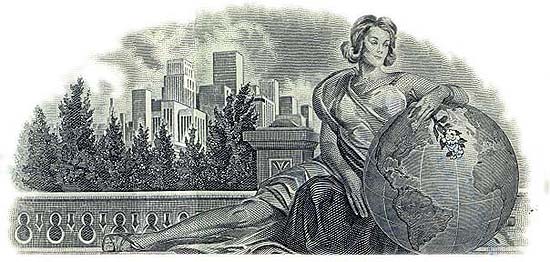| ECON 232 CHAPTER ELEVEN AGGREGATE SUPPLY AND AGGREGATE
DEMAND |
| The aggregate expenditures model developed in
Chapters 9 and 10 is a fixed-price-level model. Its focus is on changes
in real GDP, not on changes in the price level. This chapter introduces
a variable-price model in which it is possible to simultaneously analyze
changes in real GDP and the price level. This distinction should
be made explicit for those students who have covered Chapters 9 and 10.
What students learn in this chapter will help organize their thoughts about
equilibrium GDP, the price level, and government macroeconomic policies.
The tools learned will be applied in later chapters.
The present chapter introduces the concepts of aggregate demand and
aggregate supply, explaining the shapes of the aggregate demand and aggregate
supply curves and the forces causing them to shift. The equilibrium
levels of prices and real GDP are considered. Finally, the chapter
analyzes the effects of shifts in the aggregate demand and/or aggregate
supply curves on the price level and size of real GDP. |
I. Introduction to AD-AS Model
A. AD-AS model is a variable price model. The aggregate
expenditures model in Chapters 9 and 10 assumed constant price.
B. AD-AS model provides insights on inflation, unemployment and economic
growth.
|

|
II. Aggregate demand is a schedule that shows
the various amounts of real domestic output that domestic and foreign buyers
will desire to purchase at each possible price level.
A. The aggregate demand curve is shown in Figure 11-1.
1. It shows an inverse relationship between price level and domestic
output.
2. The explanation of the inverse relationship is not the same as for
demand for a single product, which centered on substitution and income
effects.
a. Substitution effect doesn’t apply in the aggregate case, since there
is no substitute for “everything.”
b. Income effect also doesn’t apply in the aggregate case, since income
now varies with aggregate output.
3. What is the explanation of inverse relationship between price level
and real output in aggregate demand?
a. Real balances effect: When price level falls, the purchasing
power of existing financial balances rises, which can increase spending.
b. Interest?rate effect: A decline in price level means lower
interest rates which can increase levels of certain types of spending.
c. Foreign purchases effect: When price level falls, other things
being equal, U.S. prices will fall relative to foreign prices, which will
tend to increase spending on U.S. exports and also decrease import spending
in favor of U.S. products that compete with imports.
B. Deriving AD-curve from aggregate expenditures model. (See Figure
11-2)
1. Both models measure real GDP on horizontal axis.
2. Suppose initial price level is P1 and aggregate expenditures AE1
as shown in Figure 11-2a. Then equilibrium GDP is GDP1. This
is shown in Figure 11-2b.
3. If price rises to P2, aggregate expenditures will fall to AE2 because
purchasing power of wealth falls, interest rates may rise, and net exports
fall. (See Figure 11-2a) Then new equilibrium is at GDP2 shown
also in Figure 11-2b.
4. If price rises to P3, real asset balance value falls, interest rates
rise again, net exports fall and new equilibrium is at GDP3. Again
see Figures 11-2a and 11-2b.
C. Determinants of aggregate demand: Determinants are the
“other things” (besides price level) that can cause a shift or change in
demand (see Figure 11-3 in text). Effects of the following determinants
are discussed in more detail in the text.
1. Changes in consumer spending, which can be caused by changes
in several factors.
a. Consumer wealth,
b. Consumer expectations,
c. Consumer indebtedness, and
d. Taxes.
2. Changes in investment spending, which can be caused by changes
in several factors.
a. Interest rates,
b. Profit expectations,
c. Business taxes,
d. Technology, and
e. Amount of excess capacity.
3. A change in government spending is another determinant.
4. Changes in net export spending unrelated to price level,
which may be caused by changes in other factors such as:
a. Income abroad, and
b. Exchange rates: Depreciation of the dollar encourages
U.S. exports since U.S. products become less expensive when foreign buyers
can obtain more dollars for their currency. Conversely, dollar depreciation
discourages import buying in the U.S. because our dollars can’t be exchanged
for as much foreign currency.
C. Aggregate demand shifts and the aggregate expenditures model:
1. When there is a change in one of the determinants of aggregate demand,
there will be a change in the aggregate expenditures as well. Look
at Figure 11-4.
2. If price level remains constant, then a change in aggregate expenditures
is multiplied and the real output rises by more than the initial change
in spending (see the lower part of Figure 11-4). The text illustrates
the multiplier effect of a change in investment spending.
|

|
III. Aggregate supply is a schedule showing level of real domestic
output available at each possible price level.
A. Aggregate supply curve may be viewed as having three distinct
segments. See Figure 11-5.
1. Horizontal range: where the price level remains constant with
substantial output variation. In this range substantial unemployment
and excess capacity exist. Economy is far below full-employment output
level.
2. Intermediate (upsloping) range: where the expansion of real
output is accompanied by rising price level, near to where the full-employment
level of output exists. Per unit production costs rise in this stage
because as resource markets near full employment their prices will be bid
up and, therefore, producer costs rise.
3. Vertical range: where absolute full capacity is assumed, and
any attempt to increase output will bid up resource and product prices.
We assume full-employment occurs at the “natural rate of unemployment.”
B. Determinants of aggregate supply: Determinants are the “other
things” besides price level that cause changes or shifts in aggregate supply
(see Figure 11-6 in text). The following determinants are discussed
in more detail in the text.
1. A change in input prices, which can be caused by changes in several
factors.
a. Availability of resources (land, labor, capital, entrepreneurial
ability),
b. Prices of imported resources, and
c. Market power in certain industries.
2. Change in productivity (productivity = real output / input) can
cause changes in per-unit production cost (production cost per unit = total
input cost / units of output). If productivity rises, unit production
costs will fall. This can shift aggregate supply to the right and
lower prices. The reverse is true when productivity falls.
Productivity improvement is very important in business efforts to reduce
costs.
3. Change in legal?institutional environment, which can be caused by
changes in other factors.
a. Business taxes and/or subsidies,
b. Government regulation.
|

|
IV. Equilibrium: Real Output and the Price
Level
A. Equilibrium price and quantity are found where the aggregate
demand and supply curves intersect. (See Key Graph 11-7a,b for illustration
of why quantity will seek equilibrium where curves intersect.) (Key
Questions 4 and 7)
B. Try Quick Quiz 11-7.
C. Shifting aggregate demand when a determinant changes will change
the equilibrium.
1. Demand-pull inflation: Shifts in the intermediate and vertical ranges
will cause demand?pull inflation with an increase in aggregate demand (Figures
11-8b and c).
2. Shifts in the horizontal range will cause quantity changes but not
price level (Figure 11-8a).
D. The multiplier effect is weakened with price level changes in intermediate
and vertical ranges of aggregate supply. Real GDP does not change
as much in Figure 11-8c as it does in Figures 11-8a even though the aggregate
demand shifts are of equal magnitude. Figure 11-9 combines the effects
of Figures 11-8a and b. Conclusion: The more price level increases,
the less effect any increase in aggregate demand will have in increasing
real GDP.
E. Decreases in AD: If AD decreases, recession and cyclical unemployment
may result. See Figure 11-10. Prices don’t fall easily.
1. Wage contracts are not flexible so businesses can’t afford to reduce
prices.
2. Also, employers are reluctant to cut wages because of impact on
employee effort, etc.
3. Minimum wage laws keep wages above that level.
4. So-called menu costs are difficult to change.
5. Fear of price wars keep prices from being reduced also.
F. Shifting aggregate supply occurs when a supply determinant changes.
(See Key Questions 5, 7, 8):
1. Leftward shift in curve illustrates cost?push inflation (see Figure
11-11).
2. Rightward shift in curve will cause a decline in price level (see
Figure 11-12). See text for discussion of this desirable outcome.
|

|
V. LAST WORD: Why Is Unemployment in Europe So High?
A. Several European economies have had high rates of unemployment
in the past several years, even before their recessions.
1. In 2000: France, 9.7 percent; Italy, 10.7 percent; Germany,
8.3 percent.
2. These rates compare to a 4.0 percent unemployment rate at the same
time in U.S.
B. Reasons for high European unemployment rates:
1. High natural rates of unemployment exist due to frictional and structural
unemployment. This results from government policies and union contracts,
which increase the costs of hiring and reduce the cost of being unemployed.
a. High minimum wages exist.
b. Generous welfare benefits exist for unemployed.
c. Restrictions against firings discourage employment.
d. Thirty to forty days of paid vacation and holidays boost the cost
of hiring.
e. High worker absenteeism reduces productivity.
f. High employer cost of fringe benefits discourages hiring.
2. Deficient aggregate demand may also be a cause as shown in Figure
11-7b. European governments have feared inflation and have not undertaken
expansionary monetary or fiscal policies. If they did, aggregate
demand would expand, and unemployment rates might drop without inflation.
3. Conclusion: Economists in Europe are not sure whether aggregate
demand is near full-employment (Figure 11-7a) or is below full employment.
|

|






